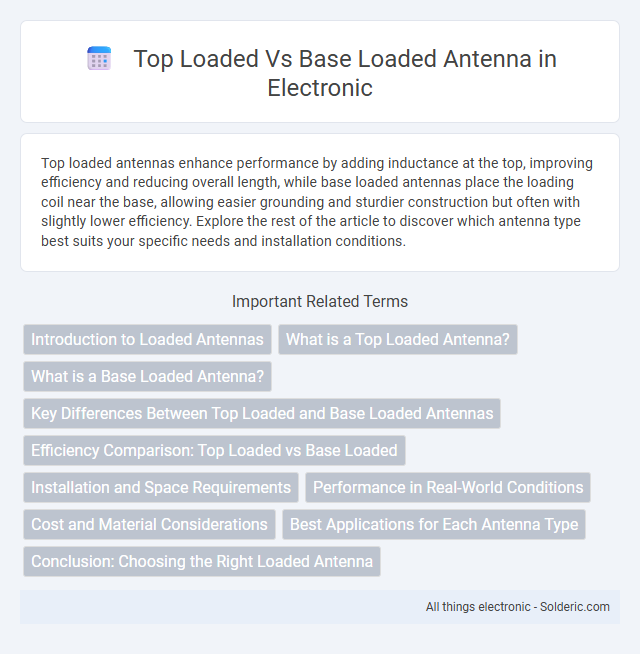Top loaded antennas enhance performance by adding inductance at the top, improving efficiency and reducing overall length, while base loaded antennas place the loading coil near the base, allowing easier grounding and sturdier construction but often with slightly lower efficiency. Explore the rest of the article to discover which antenna type best suits your specific needs and installation conditions.
Comparison Table
| Feature | Top Loaded Antenna | Base Loaded Antenna |
|---|---|---|
| Loading Location | Top of antenna element | At the base of antenna element |
| Efficiency | Higher radiation efficiency | Lower radiation efficiency |
| Physical Length | Shorter physical length for same electrical length | Requires longer physical structure |
| Tuning Complexity | More complex tuning due to distributed capacitance | Simple tuning with base coil |
| Bandwidth | Wider bandwidth | Narrower bandwidth |
| Applications | Mobile and portable radios, HF antennas | Vehicle-mounted antennas, fixed base stations |
| Mechanical Stability | Potentially less stable due to top weight | More stable as base supports entire antenna |
Introduction to Loaded Antennas
Loaded antennas use inductive or capacitive elements to electrically lengthen the antenna, improving performance without increasing physical size. Top loaded antennas feature loading coils or elements near the antenna's tip, enhancing radiation efficiency and bandwidth at higher elevations. Base loaded antennas place inductive loading at the antenna's bottom, often simplifying matching networks but may reduce overall efficiency compared to top loading.
What is a Top Loaded Antenna?
A top loaded antenna features added inductive elements or capacitive hats at its upper section to increase electrical length without physically enlarging the antenna, enhancing efficiency and bandwidth. This design makes it ideal for limited-space installations, improving signal transmission and reception by optimizing current distribution along the antenna structure. Your choice of a top loaded antenna can significantly improve performance in compact setups where base loading might be less effective.
What is a Base Loaded Antenna?
A base loaded antenna features an inductive coil placed at the antenna's base to electrically lengthen the antenna, making it resonant at desired frequencies despite its shorter physical length. This type of loading improves the antenna's efficiency and bandwidth without requiring a longer mast, which is ideal for limited-space installations. Your communication range benefits from improved signal quality and reduced power loss due to the optimized current distribution in the base loaded design.
Key Differences Between Top Loaded and Base Loaded Antennas
Top loaded antennas feature additional inductive components at the antenna's top, enhancing effective electrical length and improving performance in compact installations. Base loaded antennas incorporate loading coils near the antenna base, optimizing impedance matching and enabling efficient transmission in limited vertical space. Choosing between these designs depends on your specific application, space constraints, and desired radiation efficiency.
Efficiency Comparison: Top Loaded vs Base Loaded
Top loaded antennas generally exhibit higher efficiency than base loaded antennas due to reduced resistive losses and improved current distribution along the element. Efficiency in top loaded designs benefits from the additional capacitive reactance, which allows shorter physical antenna length without significant performance compromise. Understanding these factors can help you select the optimal antenna type for your specific communication needs.
Installation and Space Requirements
Top loaded antennas require less vertical space due to their compact design with added inductive elements on top, making them ideal for installations with height restrictions. Base loaded antennas need more ground area for proper counterpoise or radials but can be mounted lower on a support structure. Your choice depends on available space and mounting height, with top loaded antennas favoring limited height environments and base loaded ones needing sufficient ground clearance.
Performance in Real-World Conditions
Top loaded antennas generally exhibit better performance in real-world conditions, especially in limited space environments, due to their efficient use of capacitive loading which improves radiation efficiency and bandwidth. Base loaded antennas, while more compact and easier to install at ground level, often suffer from increased resistive losses and reduced effective radiation resistance, leading to lower efficiency and narrower bandwidth. Real-world factors such as nearby structures and ground conductivity further accentuate these differences, making top loaded antennas preferable for enhanced signal strength and range.
Cost and Material Considerations
Top loaded antennas typically require additional materials such as loading coils or top hats, which can increase manufacturing costs and complexity. Base loaded antennas often utilize simpler designs with a single coil at the base, resulting in lower material expenses and easier installation. Cost efficiency varies depending on application requirements, with base loaded antennas generally favored for budget-sensitive projects due to reduced material and assembly needs.
Best Applications for Each Antenna Type
Top loaded antennas excel in portable and compact mobile communication systems due to their ability to provide better performance in limited space, making them ideal for handheld radios and vehicle-mounted units. Base loaded antennas are best suited for fixed installations where space is ample, such as base stations and rooftop setups, offering efficient signal transmission and reception over longer distances. Your choice depends on whether mobility or stationary use is the priority, influencing the antenna's size and tuning requirements.
Conclusion: Choosing the Right Loaded Antenna
Top loaded antennas enhance electrical length without increasing physical height, ideal for space-constrained installations, while base loaded antennas concentrate loading coils at the base, simplifying mounting and maintenance. Your choice depends on available installation space, desired antenna height, and performance goals such as bandwidth and efficiency. Evaluating these factors ensures optimal signal transmission tailored to your specific application.
top loaded vs base loaded antenna Infographic

 solderic.com
solderic.com